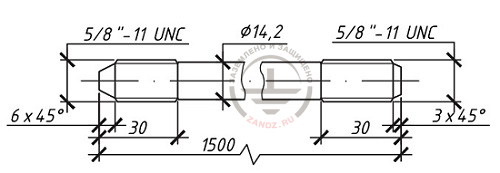
Product item:
It is a drawn steel rod with a diameter of 14 mm and a length of 1.5 meters, covered by electrolytic deposition (electrolysis) of copper with the purity of 99.9%, forming a coating of molecular and indissoluble bond to the steel.
On the edges of each rod there is thread applied by the rolling method, for the interconnection with the help of a compression coupler.
In addition to its role as a conductor, high-quality steel in such a ground electrode system performs a mechanical role necessary to plunge the electrode into the soil. The rods have a high tensile strength (600 N / mm²) and can be plunged to a great depth (up to 40 meters) into the soil using a jackhammer .
Thickness of the copper bonding is at least 0.250 mm throughout the entire length of the rod (including the thread). This ensures its (cover) resistance to bending, peeling and scratching during the installation. This is especially important on the thread where a thinner layer of copper would be completely destroyed by loads and friction with the coupler when the rod is plunged into the soil (installation) *.
These features guarantee a high corrosion resistance of the ground rod and ensure long service life (up to 100 years).
* Peculiarities of creation of thread "Correct" thread is applied AFTER coppering coating - by rolling, because this is the only way that allows to achieve high overall quality of the rod.
An alternative "technology" of copper coating: with the already formed thread (before coating) is cheaper, but it shows the worst (and dangerous during the operation) result.
This is due to the electrolysis peculiarity: thickening of the coating in the dimples / depressions, due to which the main material (steel) on the thread can only be covered with a thin (0.03 - 0.05 mm) copper layer.
This thin coating is easily damaged during the installation by strokes and friction in the coupler. In the future, at the operation of the ground electrode with such violations there appear seats of galvanic corrosion ("copper-iron"), leading to its complete destruction during 2-3 years.
| Weight: | 1,9 kg |
| Length: | 1,51 m |
| Pin diameter: | 14,2 mm |
| Thread diameter: | 16 mm |
Copper bonding technology
The key factor in the manufacture of a high-quality ground rod is formation of a firm homogeneous copper coating of the required thickness with minimal impurity elements on a steel blank.
On a separate page "Copper-bonded steel" you will see a detailed description of the main characteristics, processes during the manufacture and the held coating tests.
Comparison with galvanized rods
From 1910 to 1955 the National Institute of Standards and Technology of the United States (NIST) held an extensive study of underground corrosion, during which 36 500 samples representing 333 different coatings of ferrous and nonferrous metals and protective materials were tested in 128 locations across the United States *. This study is considered to be one of the most complete corrosion studies ever held.
One of the results of this study was the fact that the ground rod coated with 254 micron copper retains its technical characteristics for more than 40 years in the majority of soil types. A rod electrodes coated with 99.06 microns of zync can maintain their qualities in the same soils for only 10-15 years.
Besides, the term of protection of zinc coating decreases in proportion to the increase of the number of metal structures in the ground, located close to the electrodes (the more structures - the less the coating serves / the faster it "disappears"). Examples of these designs can be: reinforcement of building foundations, pipes, etc.
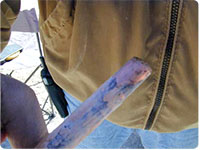
Ground rod a copper coating 254 microns thick, extracted from the soil (clay loam) after 10 years
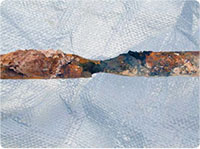
Ground rod with a zinc coating 99 microns thick, extracted from the soil (clay loam) after 10 years
Another study of corrosion properties of copper bond was held by a Polish company GALMAR. Artificial aging of samples in the conditions simulating aggressive ground ( "acid" moor), showed that the ground rod with a copper coating of 250 micron retains the necessary technical characteristics for at least 30 years.
* Publication:
Underground corrosion (United States. National Bureau of Standards. Circular 579) Author: Melvin Romanoff; Publisher: U.S. Govt. Print Off., 1957
Comparison with copper bonded rods of noname* - manufacturers
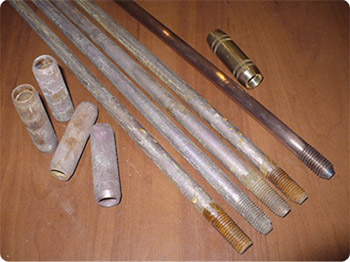
Often, noname-manufacturers use unknown materials and technologies for coating. The consequence of this is a disturbance (eg, corrosion) of the coating material at the storage warehouses.
On the right for comparison - GALMAR rod and coupler.
* noname (no name) - here: the manufacturer, not having its own brand with a market goodwill.
Ground pin sketch
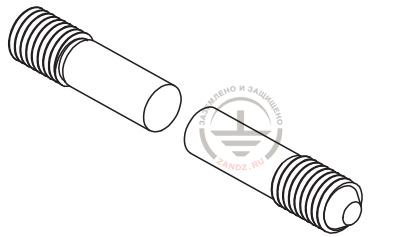
Dimensional drawing of the ground pin